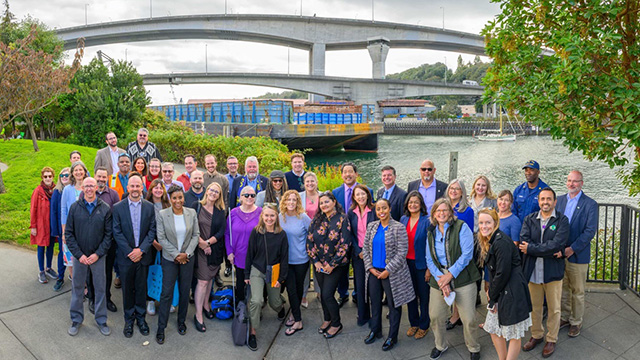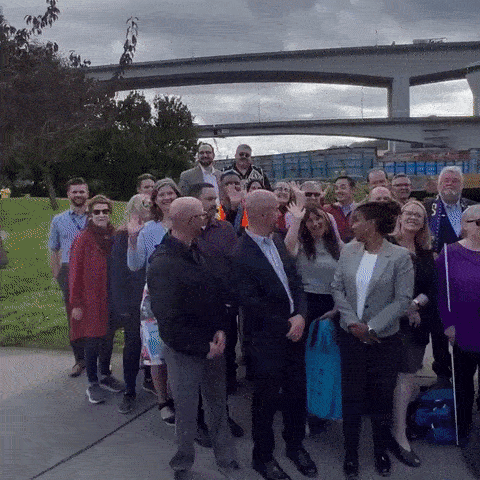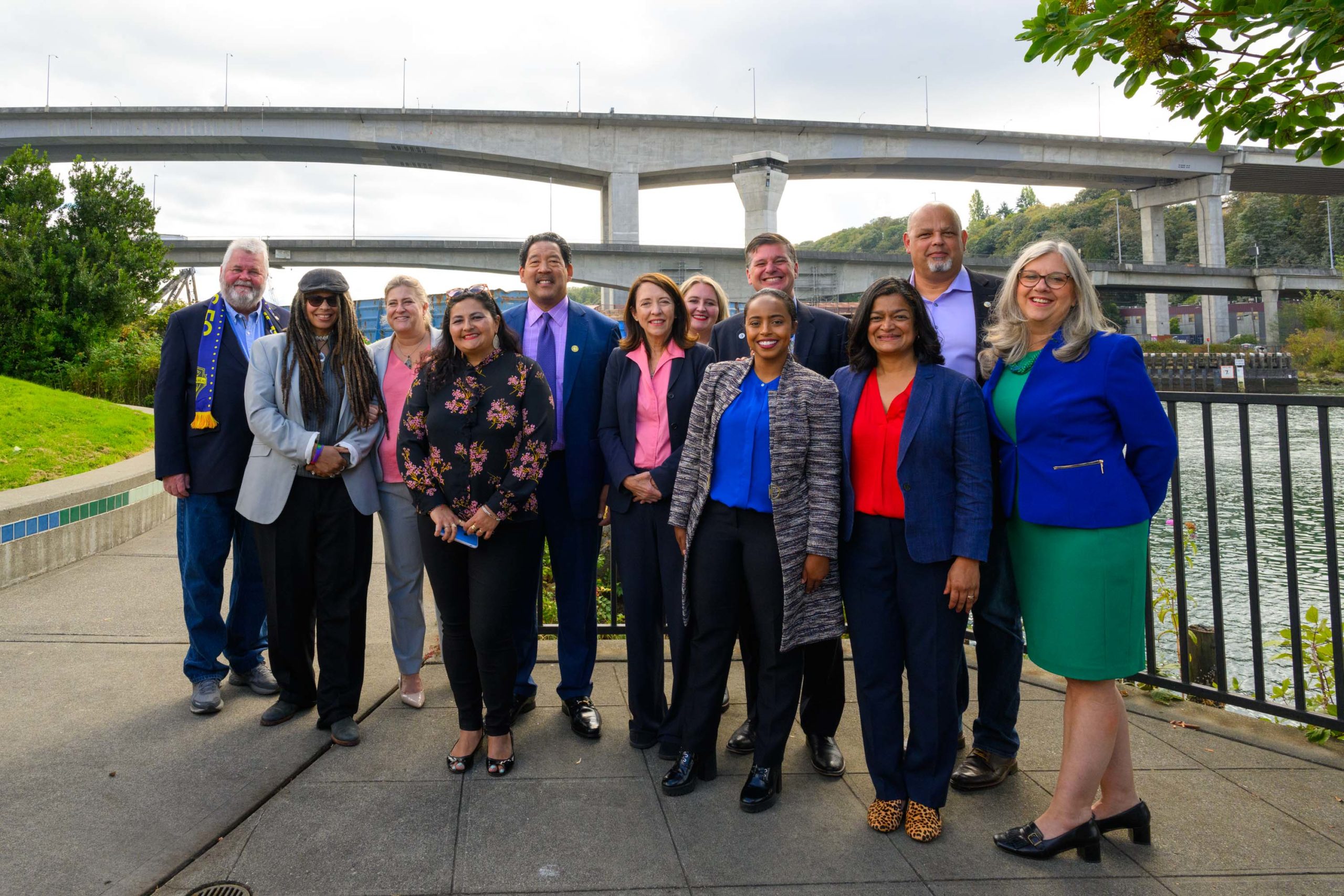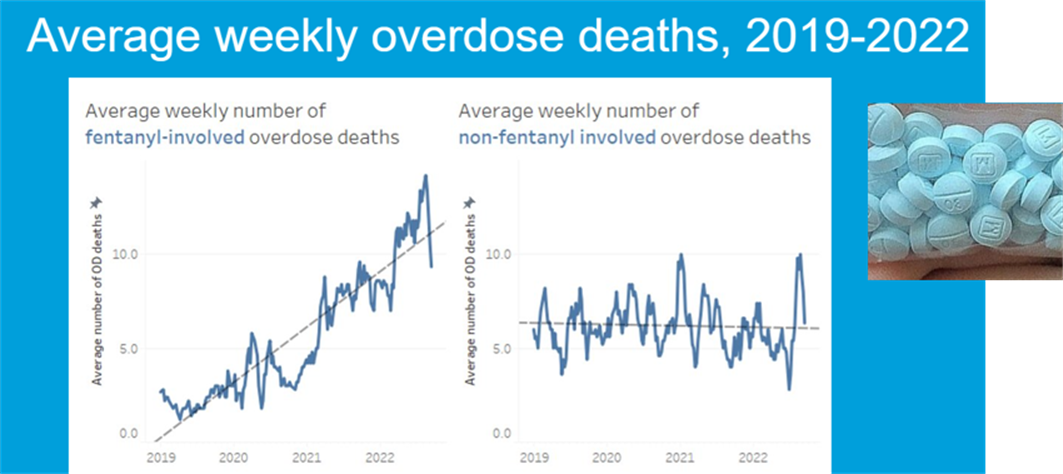West Seattle Bridge Re-opening on Sunday
Today’s press conference announcing the opening of the bridge. Watch it on the Seattle Channel.
A group shot of folks attending the press conference, framed by the West Seattle Bridge in the background. Footage courtesy of SDOT, image from the Seattle Channel.
The day that we’ve all been eagerly awaiting is nearly here: the West Seattle Bridge is set to open on Sunday, September 18th.
SDOT has said they will open the bridge as soon as they are able on Sunday. They will announce the opening on the SDOT Traffic twitter feed and the Seattledot twitter feed.
When the West Seattle Bridge opens, restrictions on the use of the Spokane Street (low) bridge will be lifted.
The remaining tasks this week have been load testing and site demobilization. Load testing was done on September 13th, with up to a dozen 80,000-pound trucks on the bridge deck, strategically placed on the bridge at one time to create a variety of traffic load scenarios. Structural engineers analyzed the data from the new sensors, and on September 15th SDOT confirmed the bridge was structurally sound and safe to open. Most of the weight the bridge supports is the structure itself; vehicle weight makes up approximately 20% of the total load.
The 24/7 live monitoring sensors added during the last two and a half years will continue to operate. My office asked about future inspections of the bridge. Those will be weekly at first, and gradually less frequent over time if results continue to be positive. The bridge now includes inspection platforms and lighting for easier access.
Other preparation work over the last week includes finishing the bridge deck overlay, pouring and installing the median barrier, adjusting signal timing, removing the bus-only lane adjacent to the low bridge, replacing copper wire for lighting, graffiti removal, removing low bridge restriction signs, and restriping the north end of Delridge Way SW and southbound SR99 approaching the bridge.
Traffic patterns will change after the bridge re-opens, so please be aware of increased traffic volumes near access points to the bridge (lest this seems too obvious for long-term residents, please keep in mind there are new residents and businesses who haven’t yet experienced traffic with the bridge being open).
The 2020 SDOT traffic report, with 2019 traffic data, showed close to 100,000 vehicles daily using the bridge, and 44,000 on Fauntleroy Way leading off the bridge, between 35th and Alaska. The 2021 report, with 2020 data after the bridge closed, showed just under 20,000 daily trips on that segment of Fauntleroy.
I want to extend my sincere appreciation and gratitude to the residents and businesses of West Seattle and Duwamish Valley communities who have shown such extended resilience and patience since the West Seattle Bridge closed two and a half years ago.
King County Metro Bus Service Update
Bus service will change with the opening of the bridge: buses that previously used the West Seattle Bridge will return to that bridge starting on Monday, September 19th. This includes the RapidRide C Line, and routes 21/21X, 50, 55, 56, 57, 120 and 125. Metro’s update says this “will reduce travel time and improve reliability for riders between West Seattle and Downtown Seattle.”
In addition, on September 17th Metro will have a revised schedule to increase reliability. Schedules are available at the September 2022 service change web page. Metro notes “The new schedule adjustments will increase reliability, more evenly space out the time between bus trips, and will preserve service where transit demand and needs are greatest. Metro is scheduling more than 11,000-weekday bus trips across King County.” In practice, there will be fewer scheduled trips, but fewer cancellations (Metro has staffing shortfalls), and hence greater reliability.
Photo courtesy of Tim Durkan
Public Safety Committee: 911 Alternatives
On September 13th the Public Safety and Human Services Committee heard an update on the work of the Council and Mayor’s office developing alternative 911 responses.
It was a brief update, focusing on what is called a “term sheet.” It is an action plan memorializing the cooperative work agreed to by the Mayor’s Office and Council Central Staff to develop and implement an alternative 911 response for calls not needing a uniformed police response. Here’s the Term Sheet Alternative 911 Response. It speaks to a shared commitment to this work and is a positive step forward. During the committee meeting, Senior Deputy Mayor Monisha Harrell spoke about this shared commitment and indicated this document shows how the Mayor’s Office and Council staff will be coming to the table together. It includes timetable targets for a comprehensive emergency response policy proposal and a pilot program proposal by the end of the year.
The Term Sheet commits to developing four work products:
- An executive-drafted policy document outlining the framework for permanent alternative response models. The policy document will be informed by a comprehensive analysis of current 911 Response including a risk management analysis, a call type analysis, and information about best practices from other jurisdictions.
- A policy proposal for an alternative response in the near term that can be designed in 2022 and become operational during 2023.
- A policy proposal for Special Event staffing that utilizes commissioned officers only where necessary. Special Event staffing is not directly related to 911 Alternative Response; the parties agree that there could be opportunities to free up scarce sworn staffing resources, but any such changes could involve considerations in the purview of the Labor Relations Policy Committee.
- A communication strategy that informs the public on the general operations of the City’s emergency response system, answers frequently asked questions, and provides clarity on how emergency responses are triaged and/or responded to.
The next committee meeting on September 27th will include a presentation by the executive on the RMD (risk management demand) study. This is a follow-up study to the 911 call analysis developed by the National Institute for Criminal Justice (commonly referred to as the “Nicjr” report). That report analyzed how a call was originally classified; the RMD analysis also includes how a call was resolved, which can differ from the original classification.
I thank the Mayor’s Office for their work on this.
South Park Public Safety Meeting
Last week I attended a South Park Public Safety forum joined by residents and business owners in South Park. Police Chief Diaz and Southwest Precinct Captain Rivera and I together answered questions from community members seeking to learn more about how SPD is investigating what appears to be an arson fire targeting a neighborhood business and an increase in gang recruitment of young people in the area. The forum was also a good opportunity to share information about public safety resources devoted to South Park and the Southwest Precinct, specifically the deployment of an SPD Community Service Officer to South Park, the South Park Public Safety Coordinator from Seattle Neighborhood Group, and the Southwest Safety Hub staff from the YMCA’s Alive and Free Program as part of the Seattle Community Safety Initiative. If you want information about these community safety interventions, I encourage you to check out the links.
I thank Carmen Martinez, Duwamish Vally Youth Corps Director, for both her work organizing the forum and her facilitation.
Fauntleroy Ferry Terminal Advisory Committee September 21 at 6 p.m.
The Community Advisory Group for the Fauntleroy Ferry Terminal project will meet on Wednesday, September 21, from 6-8 p.m. You can register for the online meeting here.
Seattle Municipal Court Community Outreach Event in Rainier Beach: Monday, September 19
Seattle Municipal Court will be holding an outreach event offering court services on September 19th from 10 a.m. to 6 p.m. at the Rainier Beach Community Center, at 8825 Rainier Avenue South. Additional information is available at the Court’s community website. Free hamburgers, chips, and soda will be available from 11 a.m. to 2 p.m.
You can download flyers in English, Amharic, Mandarin, Somali, Spanish and Vietnamese.
The Court’s announcement is below:
Seattle Municipal Court (SMC) is bringing court and social services to the Rainier Beach Community Center on Monday, September 19, 10:00 a.m. – 6:00 p.m.
Community members will get help with resolving SMC warrants and setting up payment plans or community service plans to address Seattle tickets. Visitors can also begin steps to renew their vehicle registration (tabs) if they are held up by unpaid Seattle tickets and access supportive services through the Community Resource Center.
Staff will answer questions about court processes, schedule hearings, and provide information on programs available through the court. No appointment is required. Participants can register in advance for faster check-in at the event.
Interpretation in Amharic, Mandarin, Somali, Spanish, and Vietnamese will be available.
Masks are required and health and safety measures will be in place during the event. Masks will be provided for attendees who do not have one.
This will be SMC’s first outreach event since October 2019. Outreach events were postponed during the COVID-19 pandemic.
Supportive services offered on-site at the event include*:
- SMC warrant and ticket customer service
- King County traffic ticket payment plans and removal of fines from collections
- DSHS benefit enrollment (food, cash, medical, Identicard)
- Free smartphone with data for qualifying low-income people
- Access to an attorney to talk about vacating felony drug convictions
- Public defense eligibility screening
- YWCA healthcare access
- Mental health services and resources
- Medication-assisted treatment information
- Substance use disorder treatment programs
- Housing resources
- Utility and energy bill assistance
- ORCA LIFT card and transportation resources
- Education, job placement, training, and apprenticeship programs
- Free hygiene kits
- Free lunch provided 11 a.m. – 2 p.m.
“We’re excited to get back out into the community,” said SMC Presiding Judge Adam Eisenberg. “At Seattle Municipal Court, we work hard to address the underlying causes that bring people into the legal system and to connect them with life-changing social services. But we know it can be difficult for some people to travel to our downtown courthouse, and not everyone can access services using our website. This outreach event is a great opportunity for us to connect with members of the public in a safe and convenient location.”
This outreach event is funded and supported by the court and its Community Resource Center. The Community Resource Center is a social services hub located on the second floor of the courthouse, open to the entire community, and saw nearly 7,000 visitors in 2019.
Anyone who needs assistance is encouraged to attend on Monday, September 19, 10:00 a.m. – 6:00 p.m. at the Rainier Beach Community Center, 8825 Rainier Ave S, Seattle, WA 98118. For the latest information, visit our event website: seattle.gov/courts/community.
Monkeypox Update
Dr. Matthew Golden provided a comprehensive update on the monkeypox outbreak at this week’s meeting of the Board of Health. The good news is that cases are dropping, and Public Health has been active in providing information, testing, treatment, and vaccine in a targeted way to the people who need it most.
Dr. Faisal Khan, Mayor Harrell and Executive Constantine’s new nominee to lead Public Health, responded to a question about our local monkeypox response as part of the nomination process in my Public Safety & Human Services committee meeting this week:
Having reviewed Seattle-King County’s response to Monkeypox, I can safely say that Seattle-King County Public Health (SKCPH) is undertaking the appropriate measures to prevent the spread of the disease, identify and treat cases and contacts, and vaccinate… The model jurisdictions combatting Monkeypox are NYC, LA County, and Chicago, and they’re doing what SKCPH is already doing. SKCPH is working with community and clinical partners and engaging with nightclubs and bars to provide their customers information about testing and vaccination and encouraging them to have conversations with trained medical professionals. It’s important that we sustain this work over time, even as case counts begin to drop.
Dr. Golden reported that vaccine supply from the federal government is improving and that King County is now giving most vaccines using intradermal injections, which has two advantages: 1) a lower dose is needed, and 2) it increases our vaccine supply four-fold.
Our new challenge will be to generate demand for the vaccine and expand access – particularly among the populations hardest hit. New federal guidelines require that our state must use at least 85% of the vaccine we receive to qualify for sustained supply from the Centers for Disease Control.
Board of Health Update on the Overdose Crisis
Brad Finegood of Public Health – Seattle & King County gave an update on our crisis in overdose deaths at this week’s Board of Health meeting. You can see that even after a surge in 2021, we are easily on track to exceed the number of people who die from an overdose this year.
Fentanyl is the driving factor in the surge:
Why? Fentanyl is available in multiple forms including blue pills and is being increasingly used by non-traditional users, non-opioid users, and long-term opioid users. There are easy routes of administration now, including smoking and ingesting. It’s cheap and plentiful, and it’s becoming ubiquitous. The new pills are powerful, and people are finding themselves dependent on it much more quickly than with other drugs.
Public Health is responding with a multi-channel outreach and communications campaign, as well as drug alerts, community-based “train the trainer” sessions, and expansion of harm reduction and overdose prevention supplies such as Narcan. You can learn more here.
Should You Get an Updated Covid Booster?
There’s now an updated booster vaccine for COVID-19. I know people are really tired of dealing with COVID—I feel it too. But even if you have had a booster in the past, the updated boosters will provide the best protection we have from hospitalization and death. This is especially important for people who are at increased risk for severe COVID-19, including people who have weakened immune systems or underlying medical conditions, and for people over age 50. The risk of serious infection and death go up with age.
Vaccination can also lower the risk for long COVID, which can lead to serious long-term health problems. As summer is ending and we’re all heading indoors, it’s an important time to get the updated booster to prevent what could be another wave of COVID-19.
More information about vaccine locations and appointments: kingcounty.gov/vaccine
Dr. Mark Del Beccaro, Public Health’s COVID vaccine lead, and a pediatrician and former emergency department doctor, says this:
The coronavirus changes into new variants over time. Moderna and Pfizer tailored the updated booster vaccines to protect against the variants that are circulating right now. It’s like the annual flu shot that targets the expected flu strains each flu season. The updated booster targets both the original virus strain and the most common current variants.
These updated booster vaccines use the same ingredients as their other COVID-19 vaccines, with one change to target the spike protein of the Omicron BA.4 and BA.5 variants. We expect they’ll be better at protecting us from these current variants.
You can read more here: Should I get an updated booster? We asked an expert. – PUBLIC HEALTH INSIDER.













